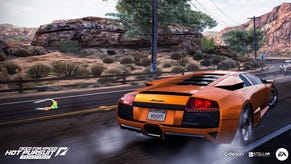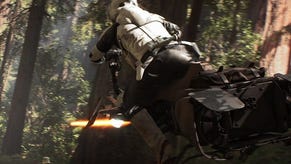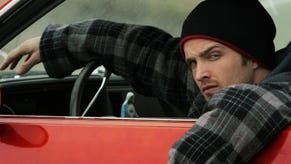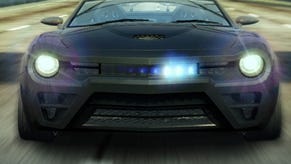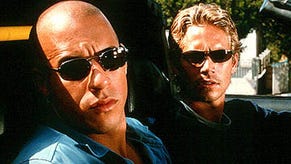Need for Speed: Hot Pursuit
Social network king.
Top Gear, season 14, episode one. Clarkson, May and Hammond traverse Romania in a range of hyper-expensive grand tourers in search of the Transfăgărăşan: 90km of high-altitude tarmac that just happens to be one of the exciting, environmentally spectacular driving routes in the world. This is the experience that sums up the new Need for Speed: Hot Pursuit - a celebration of driving some of the hottest cars in the world on the most exciting routes to emerge from the designers at Burnout studio Criterion Games.
"Let's look at the environments. They were designed here and then the guys at DICE built the world. It's all designed around the most epic drive you can go on in these amazing, really fast 250mph cars. It's all built for that," says creative director Craig Sullivan.
"The roads in this game, they're very different to what we've done before and what other people are doing at the moment. You can drive from the coast up to the desert, through the forest and up into the mountains. You can go for a 25-minute drive without seeing anything twice and you're setting times as you go, seeing your friends' comparisons pop-up. You're doing that on your own or with seven of your friends in the hottest cars in the world."
The Need for Speed game world is an interesting evolution from what we've seen before from Criterion in Burnout Paradise. For a start, it's four times larger than Paradise City and its surrounding environments, and while there is a Free Drive mode that allows you to explore and enjoy the world on your own terms, actual events are selected via the game's menu system - no more driving about the map and pulling up at traffic lights. It's just not immediate enough for the audience Criterion wants with this game.
"There's a free drive for you to enjoy the cars and set some times on the roads but the competition element is more traditional in terms of a start and a finish," says Criterion senior producer Matt Webster. "A lot of the complaints we had about Paradise were about the whole restart issue, having to drive three or four miles to go back to the start. With Need for Speed we're going to be a bit more traditional in terms of serving up the play because the most important thing for us was to get people into it, giving them a simple structure in terms of picking play."

"It's very different to Paradise City. We don't want people to worry about navigating when they're driving at 250mph. This is a faster game than Burnout. The cars actually go faster," adds Craig Sullivan. "We want you to focus on how you're driving down the road. Are you slipstreaming this guy, how am I taking the next corner, how am I going to drift around the next corner that's been designed to feel cool just to drift around..."
This game is all about some of the world's most powerful cars, and this entailed a huge re-evaluation of what worked and what didn't in Burnout Paradise. Sullivan is frank in his appraisal of elements of his previous game that didn't play as well as expected.
"In Paradise it's not very nice when you're having a good race and you take a wrong turn through no fault of your own and they just end up screwing up the race," he says. "That'll never happen in this game. Because of the way we've designed this world and the roads in it, everything should feel like an epic drive, like you're really travelling a long distance."
The team has instead focused innovation on how the various events are served up to the player. While Need for Speed: Hot Pursuit features a complete career mode for both cops and racers, you can play through the game without visiting the single-player stage selects at all. The big innovation is Autolog. Think of it as an entire social network built into the game itself, devised as an evolution in Criterion's thinking on how networked gameplay goes beyond simply playing against friends online.
Webster explains how the studio's history in creating multiplayer driving games has culminated in the creation of Autolog. "With Burnout 3, we were online for the first time - it was a whole new experience for us. With Burnout Revenge we started to track relationships between people, using stats in a human way. For Burnout Paradise it was about the friends you were playing with, not a meaningless ranking in a world leaderboard," he says. "We're more about people playing together, a social competition between people on your friends network on the console. Autolog is a suite of connective features that allow social competition."

If the core game experience is all about the joy of driving and racing, Autolog is the means with which you can share everything about what you've done in the game with your friends. Individual event performances and Paradise-style Road Rules times are constantly uploaded to the Autolog server, meaning that friends comparisons are automatically generated and displayed in just about all areas of the game.
More than that though, it's also possible to create Dream Shots within the game's photo mode for sharing, along with more immediate snapshots designed to easily grab a moment of exciting play and to share it with your friends. The innovation is that the player isn't just a spectator to this - one button puts him in the same event as the poster.
"We've got a live front-end page that changes depending on what your friends have been doing while you've been away from the game," Sullivan explains as he navigates through the Autolog screen before us. "It shows you friends, feeds, recommendations - constantly updating based on what your friends have been doing while you've been away. We've got news - that's our way of talking to the community, telling them what's coming up, what's happening. The store will allow you to buy stuff. I can sit in the feed and look at what people have been sharing from photos and what they've been talking about and what they've been saying what they've done and I can go play it straight away.
"That's a well-understood concept for this connected generation. Photos are autotagged too: where they were taken, what car it was, who's in the shot. Snapshots and Dream Shots work online. When we did Paradise, we asked players to take pictures from places where they shouldn't be or from fun places. The community loved that sort of thing, so now we have the ability in-game to go off and do that."

